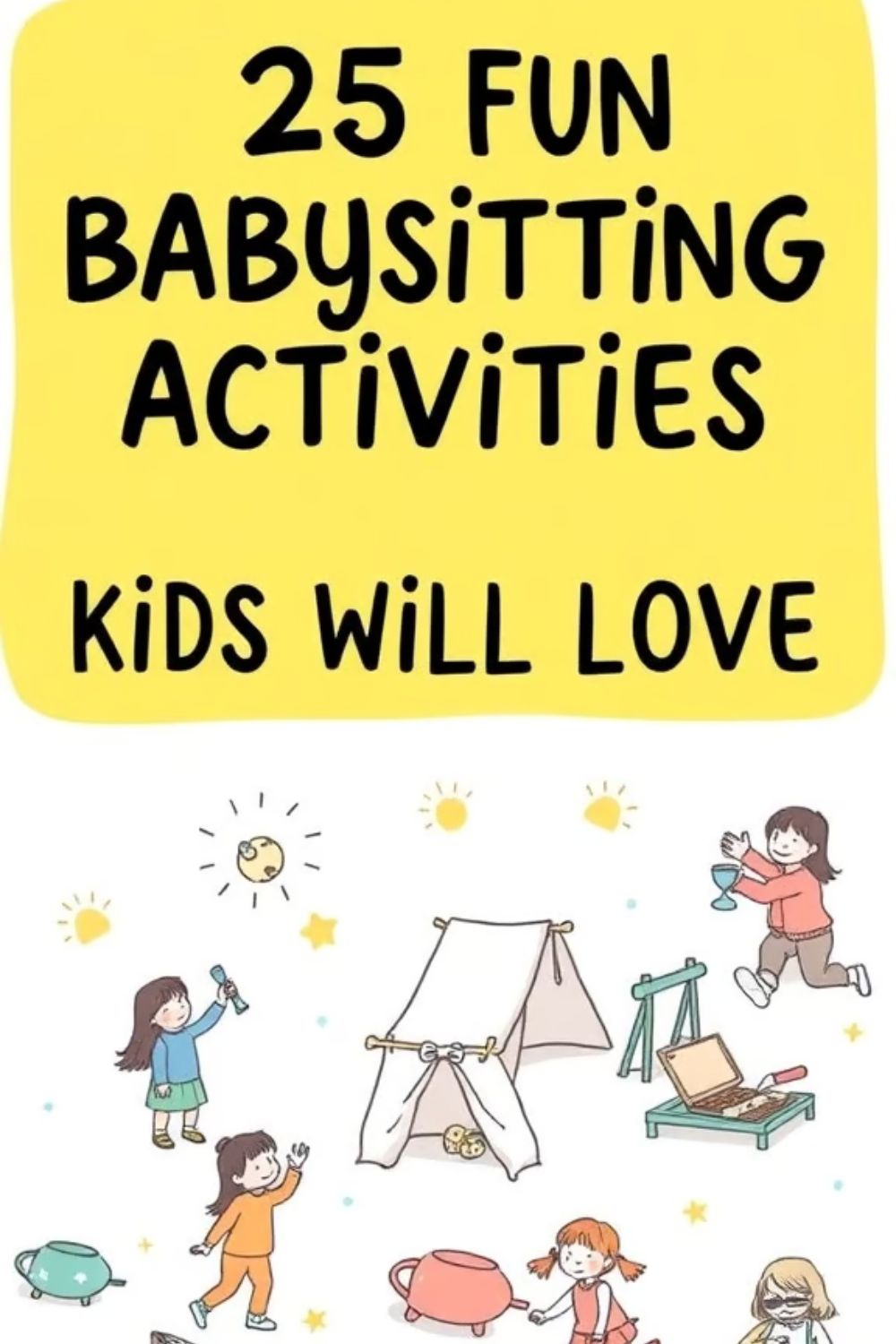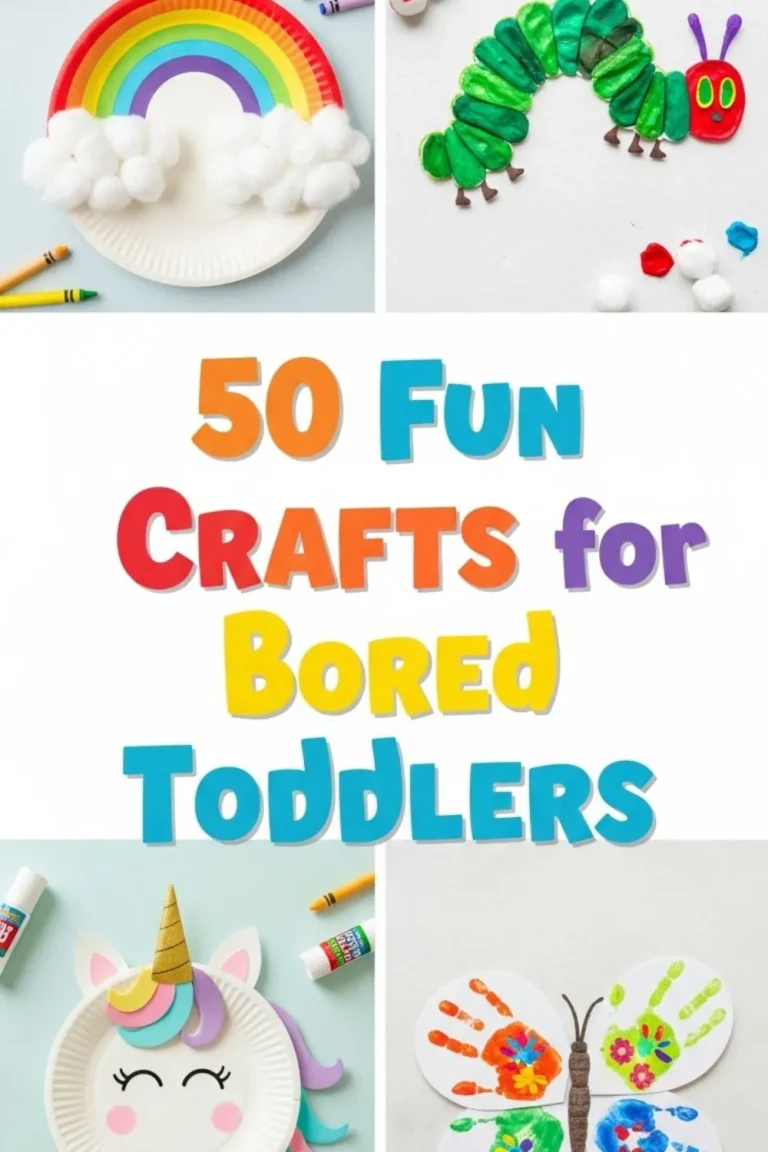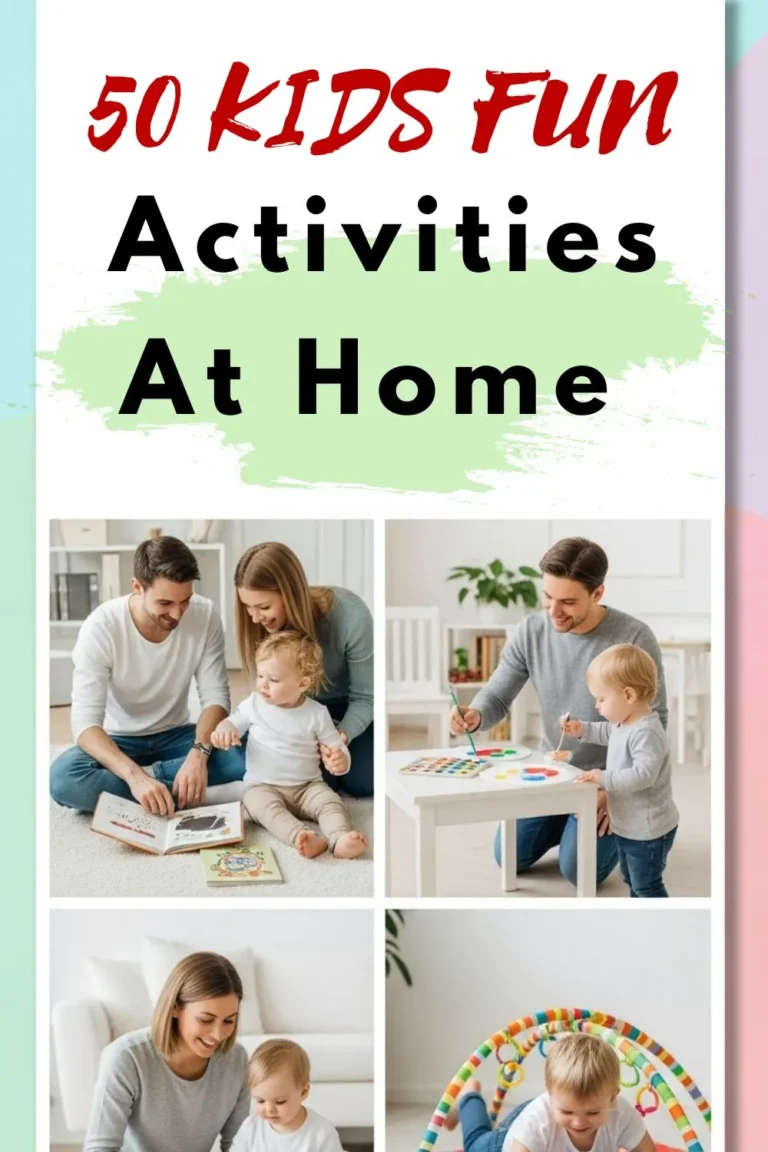25 Inside Babysitting Activities That Keep Kids Happy and Engaged

Babysitting isn’t just about keeping kids safe. It’s about keeping them curious, creative, and smiling while you’re with them. Whether you’re watching one child or a group, having a go-to list of fun activities makes everything easier and more enjoyable for both of you.
From classic games like Hide and Seek to imaginative play like puppet shows or dress-up, these activities don’t need fancy supplies or screens. Most can be done with things already in the house or out in the yard. They’re simple, low-prep ideas that keep kids moving, thinking, and laughing.
This blog post shares a collection of easy, kid-approved activities perfect for babysitters, parents, or anyone spending time with little ones. You’ll find games, crafts, indoor and outdoor ideas, and creative play that can turn an ordinary day into something special.
1. Hide and Seek

Hide and Seek is one of those timeless games that never lose their charm. Kids love the thrill of sneaking into a hiding spot and waiting to be found. It’s simple, requires no tools, and works indoors or outside.
To make it more fun, set a few ground rules. For example, limit hiding to just one floor of the house, or one section of the backyard, especially if you’re watching multiple kids. You can even give the “seeker” a fun prop, like a flashlight for a “night mission” version if you dim the lights (safely!).
Want to add a twist? Try “Sardines” — it’s like reverse hide and seek. One child hides while the rest count. When someone finds the hidden person, they quietly join them in the hiding spot until everyone’s squished together like sardines!
This game sparks laughter, builds patience, and helps kids think creatively about space and strategy. And the best part? It gives them a way to burn off energy without needing screens or fancy toys.
2. Simon Says

“Simon Says” is more than just a fun game — it’s a listening and movement challenge rolled into one! Kids love it because it’s fast, funny, and full of surprises. You don’t need any props, just your voice and imagination.
To play, one person is “Simon” and gives instructions like, “Simon says touch your nose,” or “Simon says jump three times.” If the command doesn’t start with “Simon says,” and someone still does it — they’re out for that round!
It’s a sneaky way to help kids practice focus, listening, and self-control. And you can get really creative:
- “Simon says act like a dinosaur”
- “Simon says dance like a robot”
- “Touch your toes!” (Oops! No Simon!)
You can also switch roles and let the kids be Simon — they’ll love being in charge for a bit.
Bonus: PBS featured a fun twist called “Yoyo Says” where the game includes energetic moves like high knees or arm circles — great for getting those wiggles out!
3. Bowling with Plastic Cups

This is one of the easiest and most fun games you can set up while babysitting. Just grab a few plastic cups and a soft ball, and you’ve got your own mini bowling alley right in the living room.
Start by stacking the cups into a triangle shape on the floor. Use six to ten cups, depending on how many you have. Then have the kids stand a few feet away and roll the ball to knock them down. The crashing sound of cups falling gets them every time.
Kids love the challenge of trying to knock all the cups over in one shot. You can turn it into a game with points or just let them play for fun. It’s also a great way to work on their coordination without them even realizing it.
To make it more exciting, you can decorate the cups with silly faces, add some glow sticks inside for glow bowling, or create a bowling lane using painter’s tape. Cleanup is quick, too. Just restack and play again.
4. Scavenger Hunt
Start by making a simple list of things to find. For little ones, you can include items like something red, something soft, or something round. For older kids, turn the list into clues or riddles to solve, like “Find something that changes color” or “Find something that grows but doesn’t move.”
You don’t need to hide objects unless you want to. Most times, the fun is in hunting for everyday things already around them. Give them a basket or even let them take pictures with your phone for a techy twist.
You can also turn it into a team game. Set a timer and see who finds the most in ten minutes. Want to stretch it longer? Add a second round with harder clues.
Scavenger hunts help build focus, problem-solving skills, and teamwork. Best of all, kids feel proud when they complete their list. It’s learning and fun packed into one simple activity.
5. Balloon Tennis
Balloon tennis is one of those games that kids love from the first hit. It’s easy to set up, safe to play indoors, and perfect for using up extra energy in a fun way.
To get started, you’ll need:
- A balloon
- Two paper plates
- Two sticks (like paint stirrers or wooden spoons)
- Tape or glue
Tape the sticks to the back of the paper plates to make your rackets. Then blow up a balloon, and you’re ready to go. You can tie a string between two chairs for a “net” or just play freestyle and try to keep the balloon off the ground.
This game helps kids practice hand-eye coordination while they laugh and chase the balloon around. You can add fun twists like keeping score, making up silly team names, or drawing a chalk line on the floor for a tennis court.
Even toddlers can join in. Just hand them a balloon and let them bop it around the room. Some kids love watching it float, others try to stick it to the ceiling, and many just enjoy the silly movement.
6. Freeze Dance

Freeze Dance is the ultimate mix of music, movement, and surprise. It’s super easy to play and perfect when kids need to burn off some energy indoors or outside.
All you need is a speaker or phone with music. Play a fun, upbeat song and let the kids dance around however they want. Then, randomly pause the music and yell “Freeze!” Everyone has to stop exactly where they are — no wiggling or moving allowed. If someone moves, they’re out for that round, or you can just restart and keep it silly and fun.
You can add twists like:
- “Freeze like a statue”
- “Freeze with one leg up”
- “Freeze while making a funny face”
Younger kids especially love this because it combines listening, body control, and giggles. Try songs like The Kiboomers’ Party Freeze Dance on YouTube if you want one with clear instructions built in.
7. Pop the Bubbles
Sometimes the simplest things bring the most joy, and blowing bubbles is one of those magic tricks that never gets old. All you need is a bottle of bubble solution and a wand. Blow the bubbles and let the kids chase them around trying to pop as many as they can.
This activity works both indoors (just be careful with slippery floors) and outdoors where kids can run free. Toddlers will squeal with excitement trying to catch the floating bubbles, while older kids might turn it into a game like “pop as many as you can in 30 seconds” or “don’t let the bubbles touch the ground.”
Want to make it even more fun?
- Try a bubble machine for a constant stream of bubbles.
- Use homemade bubble mix with dish soap and water.
- Give kids plastic fly swatters or foam paddles to pop the bubbles mid-air.
Besides the fun, this also helps develop hand-eye coordination, motor skills, and gives them a good dose of movement without needing anything fancy.
8. Storytelling
Storytelling is one of the most meaningful and creative things you can do with kids. It doesn’t need props, books, or screens — just your voice and imagination. Kids love hearing stories, especially ones about family, silly adventures, or even made-up fairy tales.
You can start by telling a story from your own childhood or making one up on the spot. For example, “Once when I was your age, I met a talking squirrel who loved peanut butter.” That’s all it takes to get their attention and spark their imagination.
Let the child take turns and make up their own stories. They might talk about their toy going on a trip or a banana that turns into a superhero. It doesn’t need to be perfect. The goal is fun, not grammar.
To make it more playful:
- Use a puppet or stuffed animal as the storyteller.
- Grab a few small objects (like a key, a spoon, a toy car) and ask them to build a story around what they pull from a bag.
- Change parts of familiar stories, like “The Three Little Penguins” instead of “The Three Little Pigs.”
Storytelling helps with language, memory, creativity, and emotional expression. It also builds connection between you and the child — and sometimes turns into a lot of giggles too.
9. Build Forts
Building forts is one of those childhood classics that never loses its charm. All you need are a few blankets, pillows, and maybe a couple of chairs or a sofa. Kids love turning everyday furniture into their own little hideout.
Start simple. Drape a big blanket over two chairs or the edge of a couch to create a “roof.” Stack pillows inside for a soft floor. Let the kids add stuffed animals, flashlights, or books to make it their own cozy space.
The fun isn’t just in sitting inside the fort. It’s in the building part too. They’ll move things around, problem-solve how to make the roof stay up, and feel proud of the final result.
If you have older kids, try using a fort-building kit with sticks and connectors. It becomes a hands-on building challenge and they can throw a bedsheet over it at the end.
Fort play is great for creativity and quiet time. Sometimes it becomes a secret clubhouse, sometimes a spaceship, and sometimes just the perfect reading spot.
10. Treasure Hunt
Treasure hunts are pure magic for kids. They combine curiosity, movement, and mystery into one exciting game. You don’t need anything fancy — just a few small toys or treats and some creativity.
Start by hiding small “treasures” around the house or yard. These could be coins, stickers, crayons, puzzle pieces, or little snacks. Then, create simple clues to guide the kids from one spot to the next.
Example clues:
- “I’m soft and where you rest your head” (Pillow)
- “Look where the shoes like to hide” (Closet or shoe rack)
- “Check the place where we keep things cold” (Fridge)
Each clue leads to another until they reach the final treasure. For younger kids, use pictures or one-word clues. For older ones, try rhyming hints or mini riddles.
You can even turn it into a team game or make it themed — like pirate treasure, jungle safari, or superhero search. Hide a prize at the end like a coloring book, a homemade “medal,” or a small snack bag.
11. Charades
Charades is a classic game that gets kids thinking, moving, and laughing. It’s perfect for babysitting because it doesn’t require any setup. You just need a few ideas and a little space to play.
Start by writing down simple words or phrases on small pieces of paper. These could be animals, actions, objects, or characters. Fold the papers and drop them into a bowl.
Take turns picking a paper and acting out what it says using only gestures. No talking or sound effects allowed. The others try to guess what it is. Whoever guesses it right gets a point or takes the next turn.
For younger kids, keep the clues easy:
- Brushing teeth
- Jumping
- A dog
- Eating ice cream
If a child feels shy, you can act first and let them guess. Once they see how fun it is, they’ll usually want to try acting too.
12. Draw Outside with Chalk

Drawing outside with chalk is one of the easiest and most fun ways to keep kids creative and busy. Just hand them a few pieces of sidewalk chalk and let them loose on a safe driveway, patio, or sidewalk.
Kids love the freedom of drawing big. They can doodle flowers, rainbows, their names, or even create their own games. You can suggest simple ideas like:
- Drawing a house or a car
- Making a self-portrait
- Creating a chalk maze
- Writing hopscotch numbers to jump on
You can even draw roads for toy cars or create a town with buildings, parking lots, and signs. Older kids might enjoy making word games or math challenges.
And the best part? Chalk washes away with water. So the space is ready for new art the next day.
This activity lets kids express themselves, practice writing or shapes, and enjoy the outdoors all at once.
13. Dress Up
Dress up play is pure imagination in action. Kids love trying on costumes, hats, scarves, or even grown-up clothes. It helps them explore different roles and express their creativity in a fun and playful way.
You don’t need fancy costumes. Just gather whatever you have — old shirts, hats, sunglasses, aprons, costume jewelry, and even shoes. Toss them in a box or basket and let the kids explore.
They might dress up as a chef, a firefighter, a princess, or even make up their own characters. You can guide them into pretend scenarios like running a store, hosting a tea party, or going on a space mission.
If you want to keep the fun going longer, ask questions like:
- “What’s your character’s name?”
- “Where are you going today?”
- “Can I order something from your shop?”
This kind of play boosts imagination, builds social skills, and gives them the confidence to try new ideas.
And yes, it often leads to some pretty funny photo moments too.
14. Fun with Chalk
Chalk isn’t just for drawing pictures. It’s a full toolbox for outdoor fun. Kids can use it to play games, create art, and even learn while they play.
Start by giving them a pack of sidewalk chalk and a safe surface like a driveway, sidewalk, or concrete patio. Let them draw anything they want, from rainbows and rockets to their favorite animals.
Here are a few fun chalk ideas:
- Hopscotch: Draw the squares and numbers, then take turns hopping.
- Obstacle course: Create arrows, lines to jump over, and spots to spin or balance.
- Target game: Draw circles with points inside and toss small objects to score.
- Chalk maze: Design a simple maze they can walk or drive toy cars through.
- Learning games: Practice letters, numbers, or shapes by tracing or matching.
You can even add water to the mix. Let kids use paintbrushes dipped in water to “erase” drawings or turn chalk dust into paint by adding a few drops.
15. Obstacle Course
Creating an obstacle course is a fun and active way to keep kids moving. It doesn’t need much. You can build one indoors or outdoors using whatever you have around the house.
Start by picking a space that’s safe to move around. Then set up a few simple challenges using pillows, chairs, toys, or tape. Here’s an example layout:
- Crawl under a chair
- Jump over a pillow
- Spin in a circle
- Balance on a line of tape
- Throw a soft toy into a basket
Walk the child through the course once, then let them try it on their own. You can even time them and see if they can beat their own record.
For younger kids, keep it short and simple. For older ones, make it more complex or add fun rules like hopping on one foot or walking backward.
16. Play Kitchen

A play kitchen is more than just pretend cooking. It’s a great way for kids to explore everyday routines, use their imagination, and build social skills.
You don’t need a full toy kitchen set. Even a few pots, spoons, empty containers, or plastic plates can turn into a mini cooking station. Let the kids “cook” you something and serve it like it’s a restaurant or a family meal.
You can guide them with fun ideas like:
- Make a pretend pizza
- Serve breakfast to their dolls or stuffed animals
- Open a “café” and take your order
- Wash dishes with a sponge and water (supervised)
Let them create menus, name their dishes, or even wear aprons if you have any. You can also join in and pretend to be a customer or another chef in the kitchen.
17. Playing Board Games
Board games are a great way to spend quiet, focused time with kids. They’re fun, build thinking skills, and create moments you can laugh about together.
Pick a game that matches the child’s age. For little ones, try simple games like:
- Candy Land
- Chutes and Ladders
- Memory match
- Don’t Break the Ice
Older kids might enjoy:
- Uno
- Guess Who?
- Connect 4
- Trouble
- Jenga
Let the child pick what they feel excited to play. Show them how to take turns, follow the rules, and how to be a good sport whether they win or lose.
You can also make your own mini games. Use paper and a coin to create a simple race game or draw a tic-tac-toe board with chalk.
18. Puppet Show
A puppet show is a fun and creative way for kids to use their imagination. They get to tell stories, act out scenes, and even be a little silly — all while playing.
You can use anything as a puppet. Socks with drawn-on eyes, paper bags with faces, or even cut-out characters taped to popsicle sticks. If you don’t have any of that, kids can use their hands and make finger puppets by drawing faces with a marker.
Set up a simple stage by draping a blanket over a table or two chairs. Let the kids hide behind it and pop the puppets up over the edge. They can make up their own stories or act out a favorite fairy tale.
Encourage them to give each puppet a name and a voice. Ask fun questions like:
- What’s your puppet’s favorite food?
- Where did they come from?
- Are they a hero or a villain today?
You can even record the puppet show on your phone so they can watch it afterward. Kids love seeing themselves perform.
19. Puzzles
Puzzles are a quiet and thoughtful activity that kids really enjoy. They help with problem-solving, focus, and hand-eye coordination, all while keeping kids calm and engaged.
Pick a puzzle that matches the child’s age. Younger kids might enjoy big wooden puzzles with shapes or animals. Older kids can try 24 to 100-piece puzzles with fun themes like dinosaurs, space, or fairy tales.
Start by showing them how to find edge pieces and group similar colors. Let them figure out parts on their own, but step in with help if they get stuck.
You can also try other types of puzzles like:
- Foam floor puzzles
- Magnetic puzzles
- Puzzle books
- DIY puzzles (cut up a drawing they made and mix the pieces)
Puzzles are a great way to take a break from high-energy play. They teach patience, attention to detail, and the reward of finishing something from start to end.
20. Bake Cookies
Baking cookies with kids is a cozy and creative way to spend time together. It’s hands-on, smells amazing, and gives everyone a sweet treat at the end.
You can use a simple pre-made cookie dough or mix up an easy recipe together. Let the kids help with pouring, stirring, and rolling. They can also shape the dough into balls or use cookie cutters for fun shapes.
Some easy cookie ideas for kids:
- Chocolate chip
- Sugar cookies
- Peanut butter
- Oatmeal raisin
- Sprinkle cookies
If you don’t want to use the oven, try a no-bake recipe using oats, cocoa, and peanut butter.
While the cookies are baking, talk about how ingredients work together, or let the kids decorate with icing and toppings once they cool.
21. Build a Pillow Fort
Building a pillow fort is one of those classic activities that never gets old. It turns regular furniture into a magical space where kids can play, read, or just relax.
Start with some big couch cushions, pillows, and blankets. Use chairs or the sofa as the main structure. Drape the blankets over the top to create a roof and tuck them in to hold them in place. Fill the inside with more pillows, soft toys, and maybe a flashlight or books to make it extra cozy.
Let the kids take the lead. They might turn the fort into a castle, a rocket ship, or even a secret hideout. You can help by suggesting ways to make it stronger or bigger, but try not to take over — the fun is in the building.
If they want, turn off the lights and add a small lamp or string lights inside to make it feel magical.
A pillow fort gives kids their own little space and sparks hours of imaginative play. It’s simple, soft, and always a hit.


